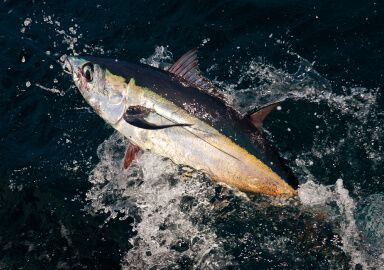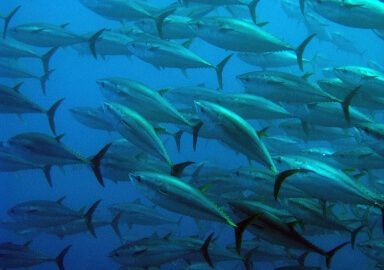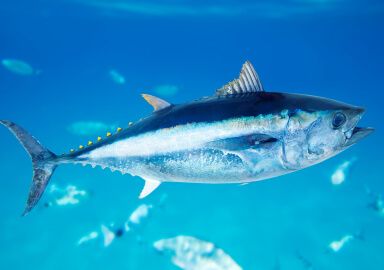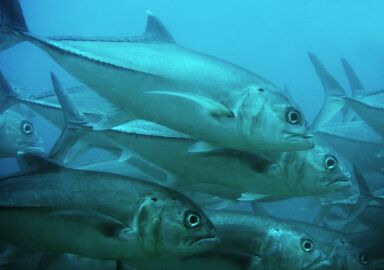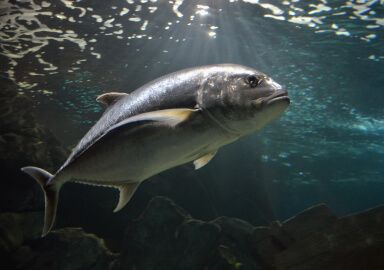Skipjack Tuna
That’s a fast one: Skipjack tuna grow fast, swim fast, and are incredibly fun to catch, offering an exhilarating experience for both novice and experienced anglers.
View 66 listings
66
listings
–
price starting from
11
countries
–
to the nearest trip
Where and When?
Skipjack tuna are widely distributed in tropical and subtropical waters around the world. They are found in oceanic, pelagic zones, often near surface waters (up to 260 meters deep). They prefer water temperatures between 15°C and 30°C, making them particularly abundant in equatorial and warm oceanic currents. Skipjack tuna tend to avoid colder waters and are mostly absent from high latitudes.
The best places for recreational fishing after skipjack tuna are found in tropical and subtropical waters worldwide, with top destinations including Hawaii, the Pacific coast of Mexico, the Indian Ocean, Southeast Asia, Australia, Cape Verde, and the Caribbean. Peak seasons tend to align with warm weather months, making summer to early fall the prime period for skipjack tuna fishing in most regions.
About Skipjack Tuna
Skipjack tuna (Katsuwonus pelamis) are relatively small compared to other tuna species, typically reaching about 40 to 60 cm in length, although they can grow up to 1 meter (around 3.3 feet) and weigh up to 34 kg (75 lbs). They are easily recognizable by their streamlined, torpedo-shaped bodies and distinct markings: dark, horizontal stripes along their bellies, which contrast against their metallic blue to purplish dorsal surface and silver sides. Their lack of scales, except on the corselet (shoulder area), and finlet structure are also characteristic.
Skipjack tuna are opportunistic carnivores, primarily feeding on small fish, crustaceans, and cephalopods like squid. They are fast swimmers and can cover large distances to follow schools of prey. As pelagic predators, they often feed in surface waters or just below, traveling in large, energetic schools, frequently associated with other tuna species, dolphins, and seabirds.
Skipjack tuna have a fast growth rate and reach sexual maturity relatively quickly, between one to two years of age, depending on environmental conditions. They are serial spawners, which means they reproduce multiple times during the spawning season. Spawning occurs in tropical waters throughout the year but peaks during warmer months in temperate zones. Female skipjack tuna can produce between 100,000 to 2 million eggs per spawning event. Their larvae are planktonic, and the young fish gradually migrate from coastal nursery areas to open ocean as they grow.
How to Catch?
Anglers often use light to medium tackle to catch skipjack tuna, since these fish, while strong fighters, do not grow as large as other tuna species. Look for skipjack tuna in deep offshore waters where they school, often near other tuna species. Skipjack tuna often feed at the surface, so look for birds diving, splashes, or baitfish springing out of the water. Skipjacks are more active in early mornings and late afternoons.
Trolling is the most common method used to catch skipjack tuna. Use multiple lines with small, fast-moving, bright and shiny lures. When you spot a school feeding near the surface, spinning can be a very effective technique, either from a stationary boat or one slowly drifting near the feeding school. Use small surface lures, jigs, or spoons. Popper lures are also highly effective for aggressive surface feeders like skipjack. A fast, erratic retrieve works best. Whether spinning or trolling, you’ll need a high-speed reel with a good drag system, and 20 to 50 lb test braided or monofilament line.
Skipjack tuna hit hard and fast, often making multiple runs. Once you feel a strike, set the hook firmly to ensure it's embedded. Skipjack have tough mouths, so a strong, sharp hook is essential. Let the fish make its initial run, then steadily reel in, applying pressure but allowing your drag system to work. Skipjack can make several strong runs before tiring. Use a net or gaff to bring the fish aboard. Be careful, as skipjack are known for their energetic thrashing once hooked, even after they seem to tire.








